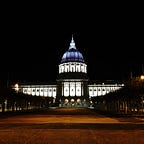The 2016 San Francisco DCCC Elections
On Tuesday, June 7th, California is holding its presidential primaries. In addition to the high-profile primaries, San Franciscans will vote on several other issues.
One of the most interesting races is the election for San Francisco’s Democratic County Central Committee, often referred to as the DCCC. Because the Democratic party has far more registered voters in San Francisco than the Republican party, the DCCC exerts substantial influence over San Francisco’s political future. The DCCC’s endorsements can influence the composition of San Francisco’s core governing body, the SF Board of Supervisors, which has not had a Republican member since 1973. In 2016, the DCCC’s endorsements may prove especially powerful, because 6 of the 11 positions on the Board of Supervisors will be up for election.
Across Assembly districts 17 and 19, 60 candidates are competing for the DCCC’s 24 seats. Every voter is allowed to select several candidates for election: in Assembly District 17, a voter can select up to 14 candidates for the DCCC; in Assembly District 19, a voter can select up to 10 candidates. Given the relative obscurity of the race compared with the presidential primaries and the complexity of selecting as many as 14 candidates, how can a San Francisco voter make an informed decision?
We decided to learn more about the candidates by gathering endorsements for the DCCC election from local political organizations, unions, and elected officials. We then applied statistical methods from political science to the endorsement data, which allowed us to rank candidates on a one-dimensional scale that captures their political positions. Following a long literature in political science, we refer to these visual representations of their political position as ideal points.
In total, we gathered endorsements from 54 different organizations and individuals. In addition to endorsing candidates for the DCCC, many of these organizations also took positions on the 7 local, regional, and state ballot initiatives. We also recorded whether an endorsing group expressed a preference between the two main candidates for State Senate: Scott Wiener and Jane Kim.
What this analysis revealed is that there is a stark choice in the upcoming election between two factions of the Democratic party. Although San Francisco would seem to have a political monoculture, it has essentially recreated a two party system for this election — except that the two parties are two subgroups of the Democratic party vying for control of the DCCC.
In addition to scoring the DCCC candidates, we also estimated ideal points for all of the seven ballot initiatives, which are listed below:
- Local A: Public Health and Safety Bond
- Local B: Park, Recreation and Open Space Fund
- Local C: Affordable Housing Requirements
- Local D: Office of Citizen Complaints Investigations
- Local E: Paid Sick Leave
- Regional AA: San Francisco Bay Clean Water, Pollution Prevention and Habitat Restoration Program
- State 50: Suspension of Legislators Amendment
In addition to allowing us to score the candidates for the DCCC and the ballot initiatives, our methodology allows us to estimate the political positions of the organizations that provided the endorsements we’ve analyzed. Like the candidates themselves, there are substantial differences between the groups that provided the endorsements we’ve analyzed.
We hope this information is useful to San Francisco residents trying to make sense of an election that is driven by political disagreements that are far removed from the conflicts that define national politics in the US. Anyone interested in reproducing our results can download all of work and data from GitHub.
Note that you can only vote for the DCCC if you are a San Francisco resident and are registered as a member of the Democratic party. You can find your voting location on the SF elections website: there are 576 locations, so there should be one near you.
[Edit History: This article was edited to use a neutral color scheme in all of the plots.]
